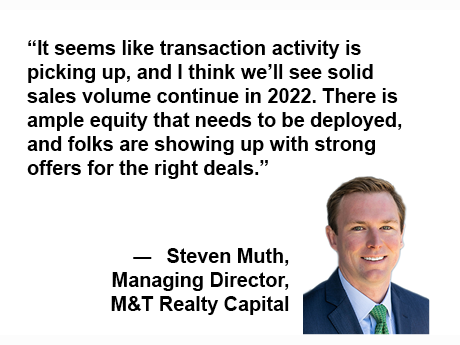A COVID-19 hangover has tested seniors housing in 2021. Low occupancy rates along with staff shortages, rising expenses and other conditions have not only created a difficult operating environment, but they also have dampened financing activity as owners have delayed putting properties on the market or seeking refinancing.
As fundamentals continue to improve, however, seniors housing finance experts are looking forward to a busier 2022. A significant rebound in demand combined with limited new supply helped push the average seniors housing occupancy rate to above 80 percent nationally in the third quarter, according to the National Investment Center for the Seniors Housing & Care Industry (NIC).
Renters absorbed more than 12,300 units in the quarter, which was the strongest single quarter showing since NIC began tracking the metric in 2005. At the same time, the addition of 3,441 units to the market was the smallest inventory increase in more than two years amid muted construction activity, the organization said.

Matt Pipitone,
M&T Realty Capital Corporation
In another sign of recovery, Nashville-based Brookdale Senior Living recently reported that as of the end of October, occupancy had grown from 70.1 percent to 74.5 percent, on average, over eight months. Similarly, Five Star Communities reported average occupancy of 74.9 percent in October, an increase of 140 basis points since June.
“We’re not back fully by any means,” says Matthew Pipitone, seniors housing platform manager with M&T Realty Capital Corporation the wholly owned commercial mortgage-banking subsidiary of M&T Bank. “But we have seen quite a bit of investor competition in markets across the country for the right deals, primarily in properties that have re-stabilized. So that has been a positive.”
Buyers Prepare
Some 16.2 billion in seniors housing and care facilities traded hands through the first 10+ months of 2021, according to Real Capital Analytics, a New York-based commercial real estate researcher that tracks sales of $2.5 million and up. As it stands, transaction volumes could very well exceed 2019’s pre-pandemic transaction volume of nearly $17.4B.
“It seems like transaction activity is picking up, and I think we’ll see solid sales volume continue in 2022,” adds Steven Muth, a managing director for M&T Realty Capital. “There is ample equity that needs to be deployed, and folks are showing up with strong offers for the right deals.”
Indeed, some of the biggest investors in seniors housing assets are fortifying their war chests. Kayne Anderson Real Estate recently netted a record $2.75 billion in commitments for its latest opportunistic fund, or $750 million more than its original target. Similarly, Harrison Street raised $2 billion in its latest real estate fund, which was oversubscribed by more than $500 million, and it raised an additional $510 million in vehicles to co-invest with the fund.
Meanwhile, healthcare infrastructure REIT Welltower is aggressively investing in seniors housing amid rising motivations to sell. In early November, it announced it was buying four seniors housing portfolios for $1.3 billion.
Lender Preference Shifts
Investment sales growth will spark more financing volume in 2022, Muth and Pipitone predict, and borrowers should find the government sponsored entities (GSEs) Fannie Mae and Freddie Mac more amenable to doing deals. While the agencies eliminated pandemic-related debt reserve requirements about midway through 2021, they remained cautious and reduced the amount of debt they would lend on properties to around 60 to 70 percent of value versus the more customary maximum of 75 percent.
As a result, more borrowers considered HUD for permanent financing. A traditional debt source for skilled-nursing facilities, HUD never implemented a standard debt service reserve requirement instituted in response to COVID, and it generally offered more consistent underwriting, competitive interest rates and higher leverage than the GSEs, Muth said. Depending on the location, sponsor and other characteristics, HUD borrowers can receive up to 80 percent of loan-to-value, for example.
But that dynamic should change in 2022. “We saw seniors housing properties that might otherwise go to Fannie and Freddie go to HUD,” Muth points out. “But looking forward, Fannie and Freddie are getting more comfortable with where the industry is in terms of occupancy and operating expenses. We expect that trend to continue as in 2022 and beyond as overall occupancies keep climbing.”
Bridge Needs
Lenders should also expect to see pent-up demand for short-term loans to allow borrowers to improve occupancy and operations in order to qualify for permanent loans. In a typical year, the GSEs and HUD typically provide about $9 billion in seniors housing financing, roughly split equally among the agencies, Muth explains.
But while HUD recorded $3.9 billion in financing activity in 2021, $1.8 billion of that was related to refinances of existing HUD loans to generate debt service savings. That means HUD provided about $1.4 billion less in new financings than it did in Fiscal Year 2020. When figuring that shortage in with the more cautious approach by Fannie Mae and Freddie Mac, new permanent debt financings remain well below the historical annual volume in more normal times.
“Using high-level math, there is about a $4 billion shortfall in permanent debt financing for seniors housing compared to what we’re used to seeing on an annual basis,” Muth said. “Going into 2022, I think we’ll see what could be a historic need for bridge financing to cover that gap.”
— By Joe Gose, contributing writer. This article was written in conjunction with M&T Realty Capital Corporation, a content partner of Seniors Housing Business.
This content is for informational purposes only. It is not designed or intended to provide financial, tax, legal, investment, accounting, or other professional advice since such advice always requires consideration of individual circumstances. Please consult with the professionals of your choice to discuss your situation.
Third-party trademarks and brands are the property of their respective owners.
All loans are subject to receipt of a completed application, credit approval and other conditions.
![]() Equal Housing Lender. © 2021 M&T Realty Capital Corporation. NMLS #1024366. M&T Realty Capital Corporation is a wholly-owned subsidiary of M&T Bank, Member FDIC. All rights reserved.
Equal Housing Lender. © 2021 M&T Realty Capital Corporation. NMLS #1024366. M&T Realty Capital Corporation is a wholly-owned subsidiary of M&T Bank, Member FDIC. All rights reserved.

